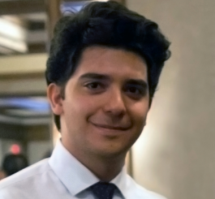
Mr. Mahdi Assefzadeh
Rice University
Thursday, March 22, 2018
1:00PM – HEC 450
Abstract
Broadband Terahertz radiation has unique applications in 3-D hyper-spectral imaging, molecular sensing, and high-speed wireless communication. THz waves interact with the rotational and vibrational transitions of molecules with applications in material detection and biomedical sensing. They also penetrate through non-metallic and non-polar mediums that can be used to image concealed objects for security purposes.
Conventional broadband THz signal radiation is based on the optical excitation of a photoconductive antenna (PCA) with a femtosecond laser pulse, a technique that is widely used in THz time-domain spectroscopy (THz-TDS) systems. Although THz-TDS is a powerful technique, its dependence on bulky, expensive and power-hungry femtosecond lasers, optomechanical components, and costly photoconductive antennas compromises its speed, accessibility and scalability. To overcome these limitations, an on-chip laser-free direct digital-to-impulse (D2I) architecture is introduced that is capable of radiating a THz pulse in silicon for the first time, by creating and exciting a broadband radiating resonator consisting of an on-chip antenna and a broadband matching network. This novel method converts a digital trigger edge to a radiated THz pulse with a high timing accuracy. Based on this timing accuracy, a novel trigger-based beam-forming architecture is also introduced that enables broadband pulse beam-steering in which all frequency content is steered simultaneously. Owing to the high scalability of the D2I architecture, combined with the broadband pulse beam-forming method, large arrays of D2I radiators can be built to radiate high-power, steerable narrow beams. In this talk, ultra-short pulse radiating sources will be presented that were used to demonstrate laser-free broadband gas spectroscopy and THz imaging.
Biography
M. Mahdi Assefzadeh received the B.S. degree in electrical engineering from Sharif University of
Technology, Tehran, Iran, in 2011, and the M.S. degree in electrical engineering from Rice University, Houston, TX, USA, in 2014, where he is currently pursuing the Ph.D. degree. He is currently a visiting re-searcher at the University of California, Los Angeles. His research focus is on broadband terahertz integrated circuits and systems in silicon technologies. Mr. Assefzadeh was a recipient of the Best Paper Award of the IEEE MTT-S International Microwave Symposium in 2014, the Best Paper Award of the IEEE Radio and Wireless Symposium in 2016, the Second Place of the Best Paper Award at the IEEE Antenna and Propagation Symposium in 2016, and the Runner-Up at the Best Paper Award of IRMMW-THz 2016. He was a recipient of the IEEE SSCS Predoctoral Achievement Award in 2018, IEEE MTT-S Microwave Graduate Fellowship in 2017, the Texas Instruments Distinguished Fellowship in 2012, and the Michael and Katherine Birck Fellowship of Purdue University in 2011. He was also the Gold Medal recipient at both the National Physics Competition in 2006 and the 38th International Physics Olympiad in 2007.